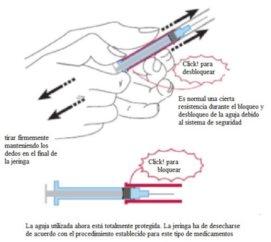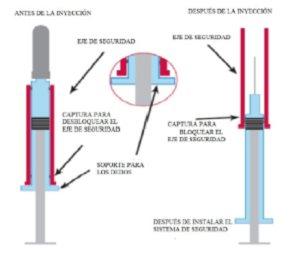
HEPAXANE 8,000 IU (80 mg)/0.8 mL PRE-FILLED SYRINGE SOLUTION FOR INJECTION
Ask a doctor about a prescription for HEPAXANE 8,000 IU (80 mg)/0.8 mL PRE-FILLED SYRINGE SOLUTION FOR INJECTION

How to use HEPAXANE 8,000 IU (80 mg)/0.8 mL PRE-FILLED SYRINGE SOLUTION FOR INJECTION
Introduction
Package Leaflet: Information for the User
Hepaxane 2,000 IU (20 mg)/0.2 mL Solution for Injection in Pre-filled Syringe
Hepaxane 4,000 IU (40 mg)/0.4 mL Solution for Injection in Pre-filled Syringe
Hepaxane 6,000 IU (60 mg)/0.6 mL Solution for Injection in Pre-filled Syringe
Hepaxane 8,000 IU (80 mg)/0.8 mL Solution for Injection in Pre-filled Syringe
Hepaxane 10,000 IU (100 mg)/1 mL Solution for Injection in Pre-filled Syringe
Hepaxane 12,000 IU (120 mg)/0.8 mL Solution for Injection in Pre-filled Syringe
Hepaxane 15,000 IU (150 mg)/1 mL Solution for Injection in Pre-filled Syringe
Sodium enoxaparin
Read all of this leaflet carefully before you start using this medicine because it contains important information for you.
- Keep this leaflet, you may need to read it again.
- If you have any further questions, ask your doctor, pharmacist, or nurse.
- This medicine has been prescribed for you only. Do not pass it on to others. It may harm them, even if their signs of illness are the same as yours.
- If you get any side effects, talk to your doctor or pharmacist. This includes any possible side effects not listed in this leaflet. See section 4.
Contents of the pack
- What Hepaxane is and what it is used for
- What you need to know before you use Hepaxane
- How to use Hepaxane
- Possible side effects
- Storage of Hepaxane
- Contents of the pack and other information
1. What Hepaxane is and what it is used for
Hepaxane contains the active substance sodium enoxaparin, which is a low molecular weight heparin (LMWH).
Hepaxane works in two ways:
- Preventing existing blood clots from getting bigger. This helps your body to break them down and stops them from causing harm.
- Preventing the formation of blood clots.
Hepaxane can be used to:
- treat blood clots.
- prevent the formation of blood clots in the following situations:
- before and after surgery.
- when you have an acute illness and are about to undergo a period of reduced mobility.
- if you have had blood clots due to cancer, to prevent the formation of new clots.
- if you have unstable angina (a condition where not enough blood reaches the heart).
- after a heart attack.
- prevent blood clots from forming in the tubes of a dialysis machine (used in people with severe kidney problems).
2. What you need to know before you use Hepaxane
Do not use Hepaxane
- If you are allergic to sodium enoxaparin or any of the other ingredients of this medicine (listed in section 6). The signs of an allergic reaction include: rash, problems swallowing or breathing, swelling of the lips, face, throat, or tongue.
- If you are allergic to heparin or other low molecular weight heparins such as nadroparin, tinzaparin, or dalteparin.
- If you have had a reaction to heparin that caused a severe decrease in the number of cells involved in blood clotting (platelets) – this reaction is called heparin-induced thrombocytopenia – in the last 100 days or if you have antibodies against enoxaparin in your blood.
- If you are bleeding heavily or have diseases with a high risk of bleeding (such as stomach ulcers, recent brain or eye surgery), including recent hemorrhagic stroke.
- If you are using Hepaxane to treat blood clots and are going to receive spinal or epidural anesthesia or lumbar puncture within 24 hours.
Warnings and precautions
Hepaxane should not be exchanged with other medicines that belong to the group of low molecular weight heparins. This is because they are not exactly the same and do not have the same activity or instructions for use.
Consult your doctor or pharmacist before starting to use Hepaxane if:
- you have ever had a reaction to heparin that caused a severe decrease in the number of platelets.
- you are going to receive spinal or epidural anesthesia or lumbar puncture (see “Surgical procedures and anesthesia”): a delay time must be respected between the use of Hepaxane and these procedures.
- you have had a heart valve implanted.
- you have endocarditis (an infection of the inner lining of the heart).
- you have a history of stomach ulcers.
- you have recently had a stroke.
- you have high blood pressure.
- you have diabetes or problems with the blood vessels in the eyes caused by diabetes (diabetic retinopathy).
- you have recently had eye or brain surgery.
- you are an elderly person (over 65 years old) and especially if you are over 75 years old.
- you have kidney problems.
- you have liver problems.
- you are underweight or overweight.
- you have high levels of potassium in the blood, which could be checked with a blood test.
- you are currently using medicines that affect bleeding (see below “Other medicines and Hepaxane”).
You may need to have a blood test before starting to use this medicine and while you are using it to check the level of cells involved in blood clotting (platelets) and potassium levels in the blood.
Other medicines and Hepaxane
Tell your doctor or pharmacist if you are using, have recently used, or might use any other medicines.
- Warfarin used to reduce blood clotting.
- Aspirin (also known as acetylsalicylic acid or AAS), clopidogrel, or other medicines used to prevent blood clots (see also section 3 “Change of anticoagulant treatment”).
- Dextran injection used as a blood substitute.
- Ibuprofen, diclofenac, ketorolac, or other medicines known as non-steroidal anti-inflammatory drugs, used to treat pain and inflammation in arthritis and other diseases.
- Prednisolone, dexamethasone, and other medicines used to treat asthma, rheumatoid arthritis, and other diseases.
- Medicines that increase potassium levels in the blood, such as potassium salts, diuretics, and some medicines for heart problems.
Surgical procedures and anesthesia
In case you are going to undergo a lumbar puncture or are going to have surgery where spinal or epidural anesthesia will be used, inform your doctor that you are using Hepaxane (see “Do not use Hepaxane”). Also, inform your doctor if you have any problems with your spine or if you have had spinal surgery.
Pregnancy and breastfeeding
If you are pregnant or breastfeeding, think you may be pregnant, or are planning to have a baby, ask your doctor or pharmacist for advice before using this medicine.
If you are pregnant and have a mechanical heart valve, you may have a higher risk of blood clots. Your doctor will discuss this with you.
Driving and using machines
Hepaxane does not affect the ability to drive and use machines.
Hepaxane contains sodium
This medicine contains less than 1 mmol of sodium (23 mg) per dose, which is essentially “sodium-free”.
It is recommended that the healthcare professional record the trade name and batch number of the medicine you are using.
3. How to use Hepaxane
Follow the administration instructions for this medication exactly as indicated by your doctor or pharmacist. In case of doubt, consult your doctor or pharmacist again.
Using the medication
- Normally, your doctor or nurse will administer Hepaxane to you. This is because it must be administered by injection.
- When you return home, you may need to continue using Hepaxane and administer it yourself (see the instructions on how to do this).
- Hepaxane is usually administered by injection under the skin (subcutaneous injection).
- Hepaxane can be administered by injection into your veins (intravenously) after certain types of heart attacks and surgical operations.
- Hepaxane can be added to the tube that comes out of the body (arterial line) at the beginning of the dialysis session.
Do not administer Hepaxane into a muscle (intramuscularly).
How much will be administered to you
- Your doctor will decide the amount of Hepaxane to be administered to you. The amount will depend on the reason you need to use it.
- If you have kidney problems, you may be administered a smaller amount of Hepaxane.
- Treatment of blood clot formation:
- The usual dose is 150 IU (1.5 mg) per kilogram of body weight per day or 100 IU (1 mg) per kilogram of body weight, twice a day.
- Your doctor will decide how long you will receive Hepaxane.
- Prevention of blood clot formation in the following situations:
- Surgical operations or periods of limited mobility due to illness
- The dose will depend on your likelihood of developing a clot. You will be administered 2,000 IU (20 mg) or 4,000 IU (40 mg) of Hepaxane per day.
- If you are going to have surgery, you will usually be given the first injection 2 or 12 hours before the operation.
- If you have reduced mobility due to illness, you will usually be administered 4,000 IU (40 mg) of Hepaxane per day.
- Your doctor will decide how long you will receive Hepaxane.
- After having a heart attack
Hepaxane can be used in 2 different types of heart attacks, called STEMI (ST-elevation myocardial infarction) or non-STEMI. The amount of Hepaxane to be administered to you will depend on your age and the type of heart attack you had.
Non-STEMI heart attack:
- The usual dose is 100 IU (1 mg) per kilogram of body weight, every 12 hours.
- Usually, your doctor will tell you to also take aspirin (acetylsalicylic acid).
- Your doctor will decide how long you will receive Hepaxane.
STEMI heart attack, if you are under 75 years old:
- You will be administered an initial intravenous injection of 3,000 IU (30 mg) of Hepaxane.
- At the same time, you will be administered a subcutaneous injection of Hepaxane. The usual dose is 100 IU (1 mg) per kilogram of body weight, every 12 hours.
- Usually, your doctor will tell you to also take aspirin (acetylsalicylic acid).
- Your doctor will decide how long you will receive Hepaxane.
STEMI heart attack, if you are 75 years old or older:
- The usual dose is 75 IU (0.75 mg) per kilogram of body weight, every 12 hours.
- The maximum amount of Hepaxane administered in the first two injections is 7,500 IU (75 mg).
- Your doctor will decide how long you will receive Hepaxane.
If you are going to have a percutaneous coronary intervention (PCI):
Depending on when you last received a Hepaxane injection, your doctor may decide to administer an additional dose of Hepaxane before a PCI. This would be by intravenous injection.
- Prevention of blood clot formation in the tubes of the dialysis equipment
- The usual dose is 100 IU (1 mg) per kilogram of body weight.
- Hepaxane is added to the tube that comes out of the body (arterial line) at the beginning of the dialysis session. This amount is usually sufficient for a 4-hour session. However, your doctor may administer an additional injection of 50 IU to 100 IU (0.5 to 1 mg) per kilogram of body weight if necessary.
Method of administration
The pre-filled syringe is ready for immediate use.
This medication should not be administered intramuscularly.
Injection through the arterial line of the extracorporeal circuit
To prevent blood clot formation in the tubes of the dialysis equipment, this medication will be injected into the tube that comes out of the body (arterial line).
Technique for intravenous injection [only for the indication of acute myocardial infarction with ST-segment elevation (STEMI)]
In the treatment of acute STEMI, treatment should begin with a single rapid intravenous injection, followed immediately by a subcutaneous injection.
Technique for subcutaneous injection (injection under the skin)
This medication is usually administered by subcutaneous injection.
The injection is best performed by deep subcutaneous injection while the patient is lying down. The administration site should be alternated between the anterolateral and posterolateral walls, alternating the left and right sides of the abdomen. A skin fold should be pinched between the thumb and index finger and the entire needle inserted vertically. The skin fold should not be released until the injection is complete.
Do not massage the injection site after administration.
If you use the 20 mg or 40 mg pre-filled syringes, do not attempt to remove the air bubble before injection, as this may result in a decrease in the administered dose.
The pre-filled syringe is for single use only.
Do not use this medication if you notice any alteration in the appearance of the solution.
How to self-administer the Hepaxane injection
If you are able to administer Hepaxane to yourself, your doctor or nurse will teach you how to do it. Do not attempt to inject yourself if you have not been trained to do so. If you have any doubts, consult your doctor or nurse immediately.
Before self-administering Hepaxane
- Check the expiration date of the medication. Do not use it if it is expired.
- Check that the syringe is not damaged and that the product it contains is a clear solution. If not, use another syringe.
- Do not use this medication if you observe any change in the appearance of the product.
- Make sure you know how much to inject.
- Check your abdomen to see if the last injection caused any redness, skin color change, swelling, discharge, or if it still hurts. If so, talk to your doctor or nurse.
- Decide where to inject the medication. Change the injection site each time you administer the medication, from the left side to the right side of your stomach. Hepaxane should be injected just under the skin of your stomach, but not too close to the navel or any scar (at least 5 cm away from these).
The pre-filled syringe is for single use only and has a safety system that covers the needle after use.
- with a safety system that protects the needle after injection.
- without a safety system that protects the needle after injection
Instructions for self-administering Hepaxane
You should lie down and administer Hepaxane by deep subcutaneous injection. Choose a area on the right or left side of your stomach. It should be more than 5 cm away from the navel and towards the sides.
The Hepaxane pre-filled syringes are for single use only and may or may not have a safety system that covers the needle after use.
Remove the pre-filled syringe from the packaging by pulling on the arrow as indicated on the packaging. Do not remove the syringe by pulling on the plunger, as this may damage it.
- Remove the needle cap by pulling it off.
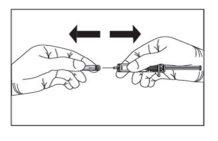
- Gently pinch the area of the abdomen you have cleaned, taking a skin fold between your thumb and index finger. Make sure not to release this fold until you have completed the injection. Insert the entire needle into the skin fold and inject the contents of the syringe by pushing the plunger to the end.
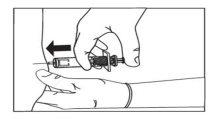
- Remove the syringe from the injection site, keeping your finger on the plunger. You can now release the pinched skin fold. To avoid the appearance of hematomas, avoid massaging the injection site after injection.
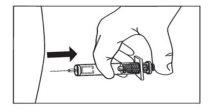
4a) For pre-filled syringes equipped with a needle protection system. After completing the injection, firmly hold the syringe cylinder with one hand. With the other hand, hold the base of the cylinder (with wing-shaped design) and pull until you hear a click. The needle is now completely covered and protected. The safety wrapper has a lock that allows you to unlock and lock the safety system.
|
|
Discard the syringe immediately in the appropriate container.
4b) For pre-filled syringes that are not equipped with a needle protection system
Discard the syringe immediately in the appropriate container.
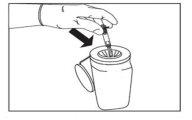
Changing anticoagulant treatment
- Changing from Hepaxane to vitamin K antagonist medications (e.g., warfarin)
Your doctor will request a blood test to determine a parameter called INR and will tell you when to stop treatment with Hepaxane.
- Changing from vitamin K antagonist medications (e.g., warfarin) to Hepaxane
Stop using the vitamin K antagonist. Your doctor will request a blood test to determine a parameter called INR and will tell you when to start using Hepaxane.
- Changing from Hepaxane to direct oral anticoagulants
Stop using Hepaxane. Start taking the direct oral anticoagulant 0-2 hours before the next scheduled injection, and then continue as usual.
- Changing from direct oral anticoagulant to Hepaxane
Stop taking the direct oral anticoagulant. Do not start treatment with Hepaxane until 12 hours after the last dose of the direct oral anticoagulant.
Use in children and adolescents
The safety and efficacy of Hepaxane have not been evaluated in children or adolescents.
If you use more Hepaxane than you should
If you think you have used too much or too little Hepaxane, inform your doctor, nurse, or pharmacist immediately, even if you do not have any signs of problems. If a child accidentally injects or swallows Hepaxane, take them to the hospital emergency department immediately.
You can also contact the Toxicology Information Service, phone 915620420, indicating the medication and the amount used.
If you forget to use Hepaxane
If you forget to administer a dose, do so as soon as you remember. Do not use a double dose on the same day to make up for missed doses. To ensure you do not miss any doses, it may be helpful to use a diary.
If you stop treatment with Hepaxane
If you have any other doubts about using this medication, ask your doctor, pharmacist, or nurse. It is important that you continue to receive Hepaxane until your doctor decides to stop treatment. If you stop using it, a blood clot may form, which can be very dangerous.
4. Possible side effects
Like all medications, this medication can cause side effects, although not everyone will experience them.
Serious side effects
Stop treatment with Hepaxane and inform your doctor or nurse immediately if you experience any signs of a severe allergic reaction (such as difficulty breathing, swelling of the lips, mouth, throat, or eyes).
Stop treatment with Hepaxane and inform your doctor or nurse immediately if you experience any of the following symptoms:
- A widespread, red, and scaly rash, with bumps under the skin and blisters, accompanied by fever. The symptoms usually appear at the start of treatment (acute generalized exanthematous pustulosis).
Like other similar medications (blood clot-reducing medications), Hepaxane may cause bleeding that could potentially be life-threatening. In some cases, the bleeding may not be apparent.
Contact your doctor immediately if:
- If you notice any episode of bleeding that does not stop by itself
- If you notice signs of excessive bleeding, such as feeling very weak, tired, pale, dizzy, or having an unexplained headache or bruise.
Your doctor may decide to keep you under close observation or change your medication.
You must inform your doctor immediately.
- If you experience any signs of a blood vessel blockage due to a blood clot, such as:
- cramping pain, redness, heat, or swelling in one of your legs, which are symptoms of deep vein thrombosis.
- difficulty breathing, chest pain, fainting, or coughing up blood, which are symptoms of pulmonary embolism.
- If you have a painful skin rash with dark red spots under the skin that do not disappear when pressed.
Your doctor may request a blood test to check the platelet count.
Other possible side effects:
Very common (may affect more than 1 in 10 people)
- Bleeding.
- Increased liver enzymes.
Common (may affect up to 1 in 10 people)
- If bruises appear more frequently than usual. This could be due to a blood problem caused by a low platelet count.
- Pink patches on the skin. These appear more frequently in the area where you have been injected with Hepaxane.
- Skin rash (hives, urticaria).
- Redness and itching of the skin.
- Bruising or pain at the injection site.
- Decrease in the number of red blood cells in the blood.
- Increase in the number of platelets in the blood.
- Headache.
Uncommon (may affect up to 1 in 100 people)
- Sudden severe headache. This could be a sign of bleeding in the brain.
- Feeling of sensitivity to the touch and swelling of the stomach. This could be indicative of a gastric hemorrhage.
- Large, irregularly shaped red lesions on the skin, with or without blisters.
- Skin irritation (local irritation).
- You may notice that your skin or eyes turn yellow, as well as a darkening of the urine color. This could be due to a liver problem.
Rare (may affect up to 1 in 1,000 people)
- Severe allergic reaction. The signs of this reaction may include: skin rash, swallowing or breathing problems, swelling of the lips, face, throat, or tongue.
- Increased potassium levels in the blood. This is more likely to occur in people with kidney problems or diabetes. Your doctor can check this with a blood test.
- Increased number of eosinophils (a type of white blood cell) in the blood. Your doctor can check this with a blood test.
- Hair loss.
- Osteoporosis (a disease in which bones can fracture more easily).
- Numbness, tingling, and weakness in the muscles (especially in the lower part of the body), when a lumbar puncture or spinal anesthesia has been performed.
- Loss of bladder or bowel control (so that you cannot control your needs).
- Hardening or nodule at the injection site.
Reporting side effects
If you experience any side effects, consult your doctor, pharmacist, or nurse, even if it is a possible side effect not listed in this leaflet. You can also report them directly through the Spanish Pharmacovigilance System for Human Use Medicines: https://www.notificaram.es. By reporting side effects, you can help provide more information on the safety of this medication.
5. Storage of Hepaxane
Keep this medication out of the sight and reach of children.
Do not use this medication after the expiration date shown on the packaging after "EXP". The expiration date is the last day of the month indicated.
Do not use this medication if you notice any visible changes in the appearance of the solution.
Do not freeze.
The Hepaxane pre-filled syringes are for single use only. Discard unused medication.
Medications should not be disposed of through wastewater or household waste. Deposit the packaging and unused medications at the SIGRE collection point in the pharmacy. If in doubt, ask your pharmacist how to dispose of the packaging and medications you no longer need. This will help protect the environment.
6. Container Content and Additional Information
Hepaxane Composition
- Each pre-filled syringe contains enoxaparin sodium with an anti-Xa activity of 2,000 IU (equivalent to 20 mg) in 0.2 mL of water for injectable preparations.
- Each pre-filled syringe contains enoxaparin sodium with an anti-Xa activity of 4,000 IU (equivalent to 40 mg) in 0.4 mL of water for injectable preparations.
- Each pre-filled syringe contains enoxaparin sodium with an anti-Xa activity of 6,000 IU (equivalent to 60 mg) in 0.6 mL of water for injectable preparations.
- Each pre-filled syringe contains enoxaparin sodium with an anti-Xa activity of 8,000 IU (equivalent to 80 mg) in 0.8 mL of water for injectable preparations.
- Each pre-filled syringe contains enoxaparin sodium with an anti-Xa activity of 10,000 IU (equivalent to 100 mg) in 1 mL of water for injectable preparations.
- Each pre-filled syringe contains enoxaparin sodium with an anti-Xa activity of 12,000 IU (equivalent to 120 mg) in 0.8 mL of water for injectable preparations.
- Each pre-filled syringe contains enoxaparin sodium with an anti-Xa activity of 15,000 IU (equivalent to 150 mg) in 1 mL of water for injectable preparations.
- The other ingredient is water for injectable preparations.
Product Appearance and Container Content
Hepaxane is a clear, colorless to pale yellow injectable solution in a pre-filled glass syringe of type I, equipped with an injection needle and needle protector. The syringe may or may not be equipped with a system that protects the needle after injection.
- Syringes equipped with a system that protects the needle after injection
- Hepaxane 2,000 IU (20 mg)/0.2 mL injectable solution in pre-filled syringes:
Cartons containing 2, 6, and 10 pre-filled syringes and multiple packs containing 12 (2 cartons of 6), 20 (2 cartons of 10), 24 (4 cartons of 6), 30 (3 cartons of 10), 50 (5 cartons of 10), and 90 (9 cartons of 10) pre-filled syringes.
- Hepaxane 4,000 IU (40 mg)/0.4 mL injectable solution in pre-filled syringes:
Cartons containing 2, 6, and 10 pre-filled syringes and multiple packs containing 12 (2 cartons of 6), 20 (2 cartons of 10), 24 (4 cartons of 6), 30 (3 cartons of 10), 50 (5 cartons of 10), and 90 (9 cartons of 10) pre-filled syringes.
- Hepaxane 6,000 IU (60 mg)/0.6 mL injectable solution in pre-filled syringes:
Cartons containing 2, 6, and 10 graduated pre-filled syringes and multiple packs containing 12 (2 cartons of 6), 20 (2 cartons of 10), 24 (4 cartons of 6), 30 (3 cartons of 10), 50 (5 cartons of 10), and 90 (9 cartons of 10) graduated pre-filled syringes.
- Hepaxane 8,000 IU (80 mg)/0.8 mL injectable solution in pre-filled syringes:
Cartons containing 2, 6, and 10 graduated pre-filled syringes and multiple packs containing 12 (2 cartons of 6), 20 (2 cartons of 10), 24 (4 cartons of 6), 30 (3 cartons of 10), 50 (5 cartons of 10), and 90 (9 cartons of 10) graduated pre-filled syringes.
- Hepaxane 10,000 IU (100 mg)/1 mL injectable solution in pre-filled syringes:
Cartons containing 2, 6, and 10 graduated pre-filled syringes and multiple packs containing 12 (2 cartons of 6), 20 (2 cartons of 10), 24 (4 cartons of 6), 30 (3 cartons of 10), 50 (5 cartons of 10), and 90 (9 cartons of 10) graduated pre-filled syringes.
- Hepaxane 12,000 IU (120 mg)/0.8 mL injectable solution in pre-filled syringes:
Cartons containing 2, 6, and 10 graduated pre-filled syringes and multiple packs containing 30 (3 cartons of 10) and 50 (5 cartons of 10) graduated pre-filled syringes.
- Hepaxane 15,000 IU (150 mg)/1 mL injectable solution in pre-filled syringes:
Cartons containing 2, 6, and 10 graduated pre-filled syringes and multiple packs containing 30 (3 cartons of 10) and 50 (5 cartons of 10) graduated pre-filled syringes.
- Syringes not equipped with a system that protects the needle after injection
- Hepaxane 2,000 IU (20 mg)/0.2 mL injectable solution in pre-filled syringes:
Cartons containing 2 and 10 pre-filled syringes.
- Hepaxane 4,000 IU (40 mg)/0.4 mL injectable solution in pre-filled syringes:
Cartons containing 2 and 10 pre-filled syringes and multiple packs containing 30 (3 cartons of 10) pre-filled syringes.
- Hepaxane 6,000 IU (60 mg)/0.6 mL injectable solution in pre-filled syringes:
Cartons containing 2 and 10 graduated pre-filled syringes and multiple packs containing 30 (3 cartons of 10) graduated pre-filled syringes.
- Hepaxane 8,000 IU (80 mg)/0.8 mL injectable solution in pre-filled syringes:
Cartons containing 2 and 10 graduated pre-filled syringes and multiple packs containing 30 (3 cartons of 10) graduated pre-filled syringes.
- Hepaxane 10,000 IU (100 mg)/1 mL injectable solution in pre-filled syringes:
Cartons containing 2 and 10 graduated pre-filled syringes and multiple packs containing 30 (3 cartons of 10) graduated pre-filled syringes.
- Hepaxane 12,000 IU (120 mg)/0.8 mL injectable solution in pre-filled syringes:
Cartons containing 10 graduated pre-filled syringes and multiple packs containing 30 (3 cartons of 10) graduated pre-filled syringes.
- Hepaxane 15,000 IU (150 mg)/1 mL injectable solution in pre-filled syringes:
Cartons containing 10 graduated pre-filled syringes and multiple packs containing 30 (3 cartons of 10) graduated pre-filled syringes.
The 6,000 IU (60 mg)/0.6 mL, 8,000 IU (80 mg)/0.8 mL, 10,000 IU (100 mg)/1 mL, 12,000 IU (120 mg)/0.8 mL, and 15,000 IU (150 mg)/1 mL pre-filled syringes are graduated.
Only some pack sizes may be marketed.
Marketing Authorization Holder and Manufacturer
Marketing Authorization Holder
Chemi S.p.A.
Via dei Lavoratori 54,
20092 Cinisello Balsamo, Milan
Italy
Manufacturer
Italfarmaco S.p.A.
Viale Fulvio Testi 330
20126 Milan
Italy
or
EUROFINS BIOLAB S.R.L.
Via Bruno Buozzi, 2 - Vimodrone - 20090 - Italy
You can request more information about this medicine by contacting the local representative of the marketing authorization holder:
ITALFARMACO S.A.
C/ San Rafael 3,
28108 Alcobendas
Madrid
Spain
This medicine is authorized in the Member States of the European Economic Area under the following names:
Belgium: Ghemaxan
Germany: Hepaxane
Denmark: Ghemaxan
Greece: Havetra
Spain: Hepaxane
Finland: Ghemaxan
Italy: Ghemaxan
Netherlands: Ghemaxan
Norway: Ghemaxan
Austria: Ghemaxan
France: Ghemaxan
Ireland: Ghemaxan
Sweden: Ghemaxan
Portugal: Hepaxane
Hungary: Hepaxane
Romania: Hepaxane
Slovakia: Ghemaxan
Date of the last revision of this leaflet: January 2023
Other sources of information
Detailed information about this medicine is available on the website of the Spanish Agency for Medicines and Health Products (AEMPS) http://www.aemps.gob.es.
You can access detailed and updated information on how to administer this medicine by scanning the QR code included in the leaflet and carton with your mobile phone (smartphone). You can also access the same information at the following internet addresses:
Hepaxane 2,000 IU (20 mg)/0.2 mL https://cima.aemps.es/info/83293
| Hepaxane 4,000 IU (40 mg)/0.4 mL https://cima.aemps.es/info/83292
|
Hepaxane 6,000 IU (60 mg)/0.6 mL https://cima.aemps.es/info/83291
| Hepaxane 8,000 IU (80 mg)/0.8 mL https://cima.aemps.es/info/83294
|
Hepaxane 10,000 IU (100 mg)/1 mL https://cima.aemps.es/info/83288
| Hepaxane 12,000 IU (120 mg)/0.8 mL https://cima.aemps.es/info/83290
|
Hepaxane 15,000 IU (150 mg)/1 mL https://cima.aemps.es/info/83289
|

How much does HEPAXANE 8,000 IU (80 mg)/0.8 mL PRE-FILLED SYRINGE SOLUTION FOR INJECTION cost in Spain ( 2025)?
The average price of HEPAXANE 8,000 IU (80 mg)/0.8 mL PRE-FILLED SYRINGE SOLUTION FOR INJECTION in December, 2025 is around 57.35 EUR. Prices may vary depending on the region, pharmacy, and whether a prescription is required. Always check with a local pharmacy or online source for the most accurate information.
- Country of registration
- Average pharmacy price57.35 EUR
- Active substance
- Prescription requiredYes
- Manufacturer
- This information is for reference only and does not constitute medical advice. Always consult a licensed doctor before taking any medication. Oladoctor is not responsible for medical decisions based on this content.
- Alternatives to HEPAXANE 8,000 IU (80 mg)/0.8 mL PRE-FILLED SYRINGE SOLUTION FOR INJECTIONDosage form: INJECTABLE, 100 mg (10000 IU) enoxaparin sodium/mlActive substance: enoxaparinManufacturer: Sanofi Aventis S.A.Prescription requiredDosage form: INJECTABLE, 120 mg (12000 IU) /0.8 mlActive substance: enoxaparinManufacturer: Sanofi Aventis S.A.Prescription requiredDosage form: INJECTABLE, 150 mg (15000 IU) /1 mlActive substance: enoxaparinManufacturer: Sanofi Aventis S.A.Prescription required
Alternatives to HEPAXANE 8,000 IU (80 mg)/0.8 mL PRE-FILLED SYRINGE SOLUTION FOR INJECTION in other countries
The best alternatives with the same active ingredient and therapeutic effect.
Alternative to HEPAXANE 8,000 IU (80 mg)/0.8 mL PRE-FILLED SYRINGE SOLUTION FOR INJECTION in Польща
Alternative to HEPAXANE 8,000 IU (80 mg)/0.8 mL PRE-FILLED SYRINGE SOLUTION FOR INJECTION in Україна
Online doctors for HEPAXANE 8,000 IU (80 mg)/0.8 mL PRE-FILLED SYRINGE SOLUTION FOR INJECTION
Discuss dosage, side effects, interactions, contraindications, and prescription renewal for HEPAXANE 8,000 IU (80 mg)/0.8 mL PRE-FILLED SYRINGE SOLUTION FOR INJECTION – subject to medical assessment and local rules.




